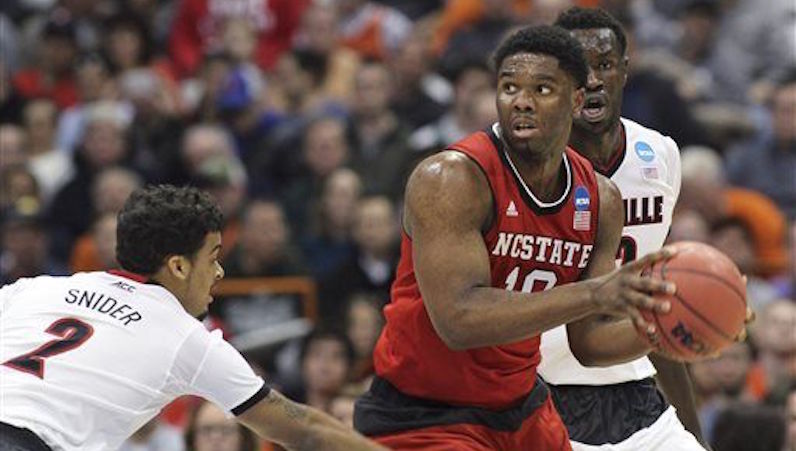NC State’s Lennard Freeman made a few headlines this week when he addressed the media before the team’s trip to Italy. A slimmed-down Freeman mentioned that he’d lost a great deal of weight under new coach Kevin Keatts’ conditioning program.
Regardless of his weight, though, the return of Freeman to the floor for the Wolfpack will be a welcomed sight. Here’s why.
Low volume, high percentage
Lennard Freeman has played in 103 career games at NC State; 53 of those contests were ACC games, too.
However, he’s scored in double figures just six times. His career high, which occurred at the 2014 ACC Tournament against Duke, is 13 points.
To say Freeman isn’t a high-volume shooter is putting it mildly; he’s a attempted more than seven shots in a game just once in his career. When he does shoot the ball, though, it’s usually close to the basketball, and it has a good chance of going in.
Freeman is a career 58.1 percent shooter on non-post-up attempts (111-of 191) around the basket, according to Synergy Sports. Most of those field goal attempts come after an offensive rebound — one of Freeman’s strengths.
Per Synergy, Freeman has connected on 53-of-91 put-back attempts (58.2 percent) after an offensive rebound in his career.
NC State’s veteran big man doesn’t have much in the way of a back-to-the-basket game or a jump shot, but that’s fine. Teams need players like Freeman, who are screeners and ball-movers. Freeman is a low-usage player (10.7 percent career usage rate), but he helps the offense flow with his activity.
Offensive rebounding
This is another area where NC State really missed Lennard Freeman last season. The 6-foot-8 forward has never finished outside the top 240 nationally in offensive rebounding rate. Freeman has never finished with an offensive rebounding rate under 10.5 percent, according to KenPom.
The high-water mark came back during his sophomore season, when Freeman grabbed 11.6 percent of the available offensive rebounds when he was on the floor. That ranked 139th in Division I ball.
In conference games of the 2014-15 season, Freeman snagged 11.1 percent of the available offensive rebounds when on the court; that ranked inside the top 10 of the ACC that season.
This matters a great deal to an NC State team that declined a great deal on the offensive glass last season sans Freeman.
| Season | Offensive rebounding rate | National rank | Wins |
|---|---|---|---|
| 2013-14 | 34.2% | No. 78 | 22 |
| 2014-15 | 33.9% | No. 82 | 22 |
| 2015-16 | 36.3% | No. 24 | 16 |
| 2016-17 | 29.8% | No. 151 | 15 |
*Rebounding stats from KenPom
That’s a roster that still featured several talented post players: Abdul-Malik Abu, Omer Yurtsever, Ted Kapita and BeeJay Anya. Freeman was the missing ingredient.
I think we can all agree that offensive rebounding isn’t the most critical function of an efficient offense; in fact, some NBA teams punt all together on sending multiple guys to the glass. However, it’s still important, especially in the college game, where teams don’t shoot as well as the professionals.
The fit next season
NC State has 80 minutes per game next season to split between the two power post positions — four and five. At times, the Wolfpack can play small — with Torin Dorn operating as the nominal four. But I’d bet that Kevin Keatts would like to have Lennard Freeman, Abdul-Malik Abu and Omer Yurtseven on the floor as much as possible.
It will be interesting to see how Keatts divides those minutes. His offenses as UNC Wilmington often played four-around-one; NC State can simulate those lineups with Dorn, but Abu, Yurtseven and Freeman don’t have the ability to stretch the floor.
That being the case, the Pack can do things to make it work. It’d be a big boon if Yurtseven could develop a passing game from the elbows. Short of that, though, Freeman is a player that can help facilitate better movement and spacing by cutting and screening.
Read More
Can NC State’s compliance office pull of another win, this time with Braxton Beverly?

















